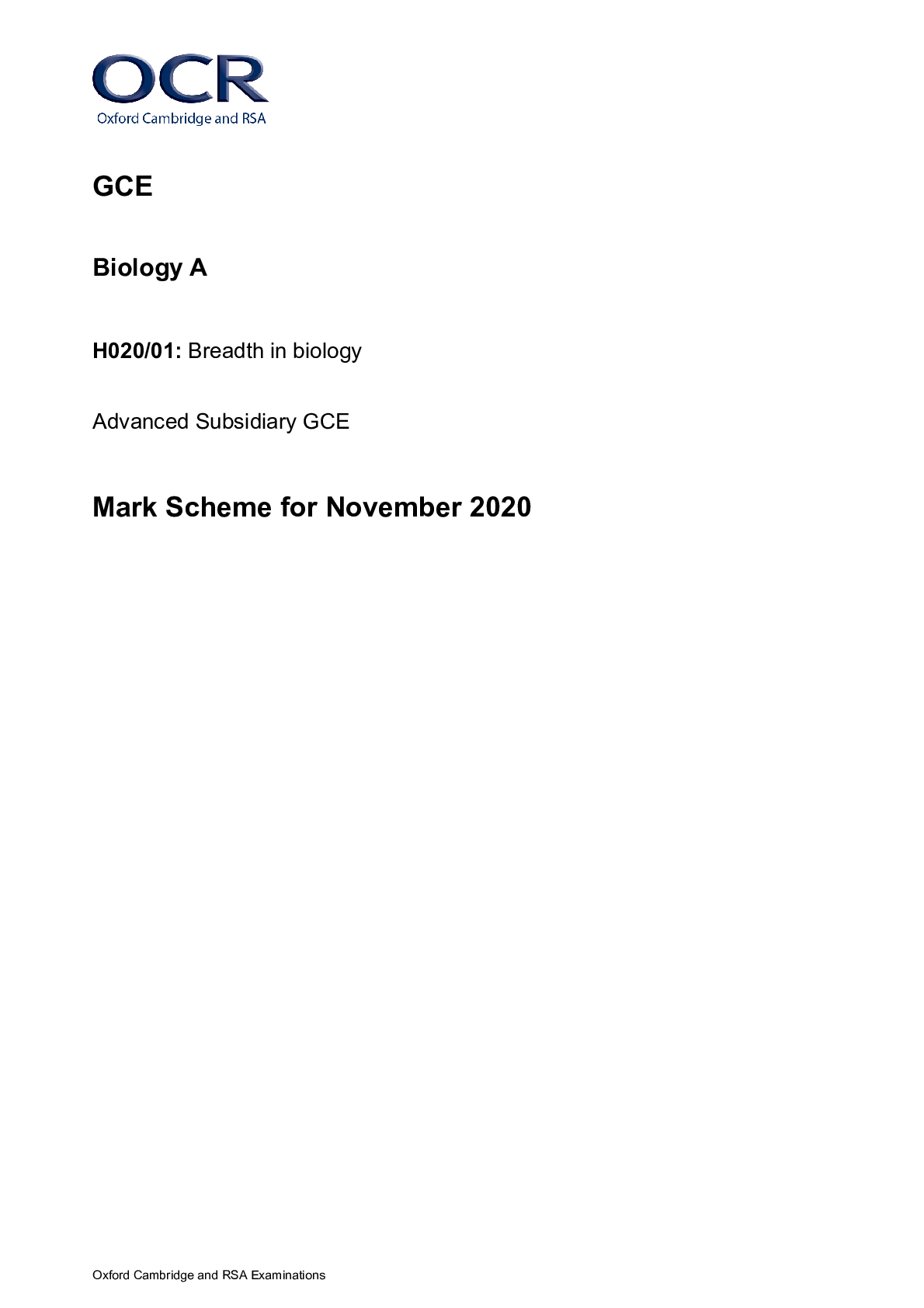Biology > GCSE MARK SCHEME > GCE Biology B H422/03: Practical skills in biology Advanced GCE Mark Scheme for November 2020 (All)
GCE Biology B H422/03: Practical skills in biology Advanced GCE Mark Scheme for November 2020
Document Content and Description Below
GCE Biology B H422/03: Practical skills in biology Advanced GCE Mark Scheme for November 2020 Oxford Cambridge and RSA Examinations GCE Biology B H422/03: Practical skills in biology Advanced GCE... Mark Scheme for November 2020Oxford Cambridge and RSA Examinations OCR (Oxford Cambridge and RSA) is a leading UK awarding body, providing a wide range of qualifications to meet the needs of candidates of all ages and abilities. OCR qualifications include AS/A Levels, Diplomas, GCSEs, Cambridge Nationals, Cambridge Technicals, Functional Skills, Key Skills, Entry Level qualifications, NVQs and vocational qualifications in areas such as IT, business, languages, teaching/training, administration and secretarial skills. It is also responsible for developing new specifications to meet national requirements and the needs of students and teachers. OCR is a not-for-profit organisation; any surplus made is invested back into the establishment to help towards the development of qualifications and support, which keep pace with the changing needs of today’s society. This mark scheme is published as an aid to teachers and students, to indicate the requirements of the examination. It shows the basis on which marks were awarded by examiners. It does not indicate the details of the discussions which took place at an examiners’ meeting before marking commenced. All examiners are instructed that alternative correct answers and unexpected approaches in candidates’ scripts must be given marks that fairly reflect the relevant knowledge and skills demonstrated. Mark schemes should be read in conjunction with the published question papers and the report on the examination. © OCR 2020H422/03 Mark Scheme November 2020 Annotations Annotation Meaning DO NOT ALLOW Answers which are not worthy of credit IGNORE Statements which are irrelevant ALLOW Answers that can be accepted ( ) Words which are not essential to gain credit __ Underlined words must be present in answer to score a mark ECF Error carried forward AW Alternative wording ORA Or reverse argumentH422/03 Mark Scheme November 2020H422/03 Mark Scheme November 2020 4 Subject Specific Marking Instructions INTRODUCTION Your first task as an Examiner is to become thoroughly familiar with the material on which the examination depends. This material includes: • the specification, especially the assessment objectives • the question paper • the mark scheme. You should ensure that you have copies of these materials. You should ensure also that you are familiar with the administrative procedures related to the marking process. These are set out in the OCR booklet Instructions for Examiners. If you are examining for the first time, please read carefully Appendix 5 Introduction to Script Marking: Notes for New Examiners. Please ask for help or guidance whenever you need it. Your first point of contact is your Team Leader.H422/03 Mark Scheme November 2020 Question Answer Mark AO element Guidance 1 (a) i Explanation must be qualified and correspond to the variable Credit any two pairs speed / gradient (of treadmill) ✓ because (higher speed/gradient) creates higher energy demands for body and higher heart rates ✓ health of participant / smoking ✓ because heath conditions / smoking, (may) increases heart rate ✓ BMI / obesity ✓ because high(er) BMI / obesity, increases heart rate ✓ sex ✓ because males (tend to) have higher heart rate ✓ age of participants ✓ because older people have lower heart rates ✓ initial fitness of the subject ✓ because fitter people have lower (resting) heart rates ✓ max 4 AO 2.7 ALLOW ‘pulse rate’ as alternative wording for ‘heart rate’ IGNORE ‘speed person ran’ as unrelated to the treadmillH422/03 Mark Scheme November 2020 1 (a) ii Any two from from a larger sample so, more (likely to be) reliable ✓ peer reviewed so, conclusions more valid ✓ different methods (may have been used) so, achieved reproducibility ✓ idea that procedure used to collect secondary data (may have) used a more, accurate / precise, methodology, so improved accuracy of data (obtained) ✓ max 2 AO 2.5 Must explain point for mark (b) i Description (slight) increase in heart rate ✓ Explanation anticipatory response/ increases delivery of oxygen to muscles in anticipation of exercise OR caused by release of, neurotransmitters / noradrenaline / adrenaline ✓ 2 AO 2.3 ALLOW use of data to show increase of heart rate IGNORE ‘HR changes’ as this could be an increase or a decrease in the HR 1 (b) ii 23925 AND cm3 min-1 ✓ 1 AO 2.4 Correct answer only: 165 x 145 = 23925 Must include units for mark. ALLOW correct answer in other form, e.g. 23.925dm3 min-1, 23925 ml min-1 1 (b) iii less time for ventricles to fill so, stroke volume is lower ✓ 1 AO 2.3 ALLOW ref to incomplete filling of ventricles and reduced SVH422/03 Mark Scheme November 2020 1 (c) i Elevation of the ST section ✓ Abnormally shaped P-wave Deep S wave 1 AO 1.2 1 (c) ii (cardiac) muscle in atrial wall contracts, arrhythmically / in an uncoordinated way AND inefficient filling of ventricles ✓ 1 AO 2.5H422/03 Mark Scheme November 2020 1 (d) Read through the whole answer. (Be prepared to recognise and credit unexpected approaches where they show relevance.) Using a ‘best-fit’ approach based on the science content of the answer, first decide which of the level descriptors, Level 1, Level 2 or Level 3, best describes the overall quality of the answer. Then, award the higher or lower mark within the level, according to the Communication Statement (shown in italics): award the higher mark where the Communication Statement has been met. Award the lower mark where aspects of the Communication Statement has been missed. • The science content determines the level. •The Communication Statement determines the mark within a level. A level annotation should be used where all marks for a level have been achieved e.g. for 6 marks L3, 5 marks L3∧ etc. No marks (0) should have a cross Level 3 (5-6 marks) Describes and explains both benefits and drawbacks, with conclusion drawn. Detailed evidence of using information from both statements 1 and 2. There is a well-developed line of reasoning, which is clear and logicallystructured and uses scientific terminology at an appropriate level. The information presented is relevant and substantiated. Level 2 (3-4 marks) Describes some benefits and drawbacks and explains at least one benefit and at least one drawback in detail. Evidence of using information from either statements 1or statements 2. There is a line of reasoning presented with some structure and use of appropriate scientific language. The information presented in the most part relevant and supported by some evidence. Level 1 (1-2 marks) Describes some benefits or drawbacks. Information from statement 1 and 2 may not be stated clearly. There is an attempt at a logical structure with a line of reasoning. The information is mostly relevant. 0 marks 6 AO 3.2 Indicative marking points may include: Benefits/ advantages : • Unexplained symptoms may have an effect on quality of life and may lead to anxiety • Patients are reassured and further investigations can be avoided • Results are immediately available • Less disruption to lifestyle than other cardiac monitors • Less additional cost to NHS than cardiac monitors. • The knowledge allows doctors to make more informed treatment decisions e.g. such as medication dosage • Other indicators of (later onset) heart disease are painful and frightening – e.g. pressure in chest, breathlessness, discomfort • Patient is involved in diagnosis of symptoms • Less need for training in emergency treatment of heart attacks e.g. defibrillator, CPR • Median time from symptoms to diagnosis relatively short • Less need for GP/ consultant appointment time • No need for specialist to fit deviceH422/03 Mark Scheme November 2020 No response or no response worthy of credit. Drawbacks/disadvantages: • (Older) people, who are at greater risk of heart disease, may not possess compatible smartphones • Patients may not use the smartphone app correctly • No evidence of correlation between use of smartphone app and decreased GP consultation • New device not fully tested on trialled over many years • May create fear /worry from user as they can access data / trace in real time • Battery life of smartphone may affect the long-term use of the app • Quality of trace not as good as the CEM /standard hospital ECG with 12 electrodes • Older people, who are at greater risk of heart disease, may not have confidence in technology • Less data is collected as a result of lack of continual recording (as compared to CEM being worn continuously) • Patients may not use the app if they fail to recognise their own symptomsH422/03 Mark Scheme November 2020 Question Answer Mark AO element Guidance 2 (a) i 15.50 ✓✓ Ascending rank Sample Petiole length (mm) Rank Leaf width (mm) Rank d d2 1 28 2 52 3.5 -1.5 2.25 2 30 3 55 5 -2 4 3 17 1 31 1 0 0 4 31 4 52 3.5 0.5 0.25 5 35 6 56 6 0 0 6 45 7 61 7 0 0 7 46 8 62 8 0 0 8 77 10 98 10 0 0 9 33 5 40 2 3 9 10 57 9 69 9 0 0 Total 15.50 Descending rank Sample Petiole length (mm) Rank Leaf width (mm) Rank d d2 1 28 9 52 7.5 1.5 2.25 2 30 8 55 6 2 4 3 17 10 31 10 0 0 4 31 7 52 7.5 -0.5 0.25 5 35 5 56 5 0 0 6 45 4 61 4 0 0 7 46 3 62 3 0 0 8 77 1 98 1 0 0 9 33 6 40 9 -3 9 10 57 2 69 2 0 0 Total 15.50 2 AO 2.8 ALLOW 15.5 1 mark for both rank columns correct OR any correct column for d OR d2 (also allowing ECF for incorrect rankings) 2 (a) ii rs = 0.9061 ✓✓ 2 AO2 ALLOW ECF from Q2ai Answer must be given to 4dp (refer to table in Q2aiii) ALLOW one mark if calculated correctly but not given to 4dpH422/03 Mark Scheme November 2020 2 (a) iii reject the null hypothesis because: (degrees of freedom is 10 so) critical value (at p=0.05) = 0.6485 ✓ calculated value is greater than the critical value, so correlation significant (at 0.05 level) ✓ correlation is, a weak positive ✓ results are not due to chance ✓ max 2 AO 2.8 Candidates should use n = 10 and critical value at p=0.05 / 95% confidence level ALLOW ECF for correct interpretation of incorrect calculation of rs from Q2aii No mark for stating ‘reject null hypothesis’ without explanation ALLOW ‘(relatively) strong’ 2 (b) Adaptation Behavioural Physiological Anatomical Stomata open only at night ✓ Stem becomes more rounded with fewer folds when water is available ✓ Stomata are located in sunken pits ✓ 3 2 (c) i Control (group), for /to allow, comparison ✓ 1 AO 3.1H422/03 Mark Scheme November 2020 2 (c) (ii)* Please refer to the marking instructions on page 4 of this mark scheme for guidance on how to mark this question. In summary: Read through the whole answer. (Be prepared to recognise and credit unexpected approaches where they show relevance.) Using a ‘best-fit’ approach based on the science content of the answer, first decide which of the level descriptors, Level 1, Level 2 or Level 3, best describes the overall quality of the answer. Then, award the higher or lower mark within the level, according to the Communication Statement (shown in italics): o award the higher mark where the Communication Statement has been met. o award the lower mark where aspects of the Communication Statement have been missed. • The science content determines the level. • The Communication Statement determines the mark within a level. Level 3 (5–6 marks) Balanced, detailed evaluation with both supporting and undermining statements using information from Fig. 2.2a and Fig. 2.2b/c There is a well-developed line of reasoning which is clear and logically structured. The information presented is relevant and substantiated. Level 2 (3–4 marks) Evaluation with both supporting and undermining statements using information from Fig. 2.2a and Fig. 2.2b/c There is a line of reasoning presented with some structure. The information presented is in the most-part relevant and supported by some evidence. Level 1 (1–2 marks) Limited evaluation with basic descriptive statements that may not include reference to Fig. 2.2a and Fig. 2.2b/c The information is basic and communicated in an unstructured way. The information is supported by limited evidence and the relationship to the evidence may not be clear. 0 marks No response or no response worthy of credit. 6 AO3.2 AO3.3 Indicative scientific points may include (not exhaustive): ALLOW ORA to shade species throughout Supporting statements: • chloroplast from M.o (2.2a) shows more similar ultrastructure to M. g chloroplast in sun conditions (2.2b) • chloroplast from M.o (2.2a) and chloroplast from M.g in sun conditions have similar sized grana / thylakoid stacks (2.2b) • chloroplast from M.o (2.2a) and chloroplast from M.g in sun conditions (2.2b) have similar numbers of grana • chloroplast from M.o (2.2a) and chloroplast from M.g in sun conditions (2.2b) have similar numbers of thylakoids per granum • chloroplast from M.o (2.2a) don’t need as many thylakoids / grana for light capture as they are in high light intensity • fewer thylakoids in both chloroplasts from M.o (2.2a) and chloroplasts from M.g in sun conditions (2.2b) than chloroplast from M.g in shade conditions (2.2c)H422/03 Mark Scheme November 2020 Undermining statements: • only have one drawing of a chloroplast from each micrograph • student’s drawings may be inaccurate • chloroplasts / leaves from extinct species may have been damaged • images / electron micrographs may have been poor quality • methods of obtaining the leaf samples may have been different • more data required to draw this conclusion • there (maybe) different numbers of chloroplasts in different species • there (maybe) different numbers of leaves in different speciesH422/03 Mark Scheme November 2020 Question Answer Mark AO Guidance 3 (a) (i) Line measured as 112mm = 28.0 (µm) and 114mm = 28.5 (µm) 28.0 to 28.5 (µm) ✓✓ 2 AO 2.8 Only allow values within the range (using image size 112 to 114) ALLOW one mark as ECF for incorrect measurement provided there is evidence of rearranging formula AND showing working AND answer given to 3 sf i.e. = incorrect measured value = ECF value to 3sf 4000 3 (a) (ii) iodopsin ✓ 1 AO1.1 3 (a) (iii) MARK FIRST TWO REPONSES procedure is more technical / requires more advanced practical skills / AW ✓ further detail of skill required e.g. complex staining process needed to prepare specimens ✓ artefacts may occur ✓ 2 max AO 2.7 IGNORE Specimens must be placed in a vacuum and so must be dehydrated / dead as image 3.1 is a section of tissue IGNORE reference to black and white images as this is not related to the preparation of the image IGNORE references to costH422/03 Mark Scheme November 2020 3 (b) ✓✓✓ Label Name Function A ciliary muscle alter shape of lens B iris Control amount of light entering the eye C lens Focusses light rays D cornea Refracts light (to retina) E retina Contains photoreceptors / converts light energy to action potentials F choroid Pigmented layer to prevent internal reflection 3 AO 1.1 ALL six rows correct 3 marks Four or five rows correct 2 marks Two or three rows correct 1 mark One row correct 0 marks 3 (c) Only allow 2 marks maximum from any one area to ensure candidates address both parts of the question Equipment use scissors, to cut away fatty tissue ✓ use scalpel, to remove, (rectus) muscles / fine sections of fat / make an incision in sclera ✓ use blunt seeker, to separate lens ✓ Safe working (prevent) contamination from tissue or fluid, by wearing gloves / using mat / disinfecting instruments / washing hands / use of biological waste bin ✓ (prevent) injury from scalpel / scissors, by cutting away from body ✓ (prevent) allergic reaction, by assessing before starting dissection ✓ 3 max AO 1.1 Marks for equipment must give name of equipment AND use for each mark Marks for safe working points must be linked to preventative actionH422/03 Mark Scheme November 2020 3 (d) i histogram drawn (with bars touching), with appropriate bar widths for each age category ✓ X axis labelled as “age / years ” AND Y axis labelled as ‘Frequency Density’ AND plot area covers 50% of the available space ✓ all data plotted correctly ✓ 3 AO 2.8 Do not award mp1 if there is a line of best fit also plotted through histogram ALLOW +/- 0.5 small square 3 (d) ii (total = 198 + 540 =) 738 ✓✓ 2 69-63 = 6 x 33 = 198 81-69 = 12 x 45 = 540 View of 198 or 540 gains 1 mark 3 (d) iii large sample size: is more representative of the (actual) population OR gives a more accurate mean / is more likely to lie close to the true mean OR reduces the impact of anomalous results (on the mean) ✓ 1 3 (d) iv regional differences in incidence may relate to regional differences, in the organisation / delivery, of screening programmes ✓ uptake of screening and (as a result) opportunities for diagnosis, may be lower in rural versus urban areas (due to decreased accessibility of screening services) ✓ challenges in identifying diabetic retinopathy, including communication with screening services / communication with patients ✓ 2 max AO 3.4H422/03 Mark Scheme November 2020 Question Answer Mark AO Guidance 4 (a) Plan should only show tissue regions and no cellular detail Entire specimen drawn AND 4 distinct regions shown AND drawn to appropriate scale AND covering a minimum of 50% of the box ✓ Sharp, clear and continuous lines drawn for each region AND label lines are drawn with a ruler and do not have arrow heads ✓ the 4 specified tissues labelled correctly ✓ any 4 tissues annotated correctly ✓ 4 AO 2.3 There should not be any shading or other detail within the plan DO NOT ALLOW (mp1) if cells drawn DO NOT ALLOW (mp1) if the diagram has clearly just been traced DO NOT ALLOW (mp2) if label lines are not ruled or if the label lines have arrowheads Examples of suitable labels and annotations • grey matter = dark(er) pink/purple • white matter = light(er) pink/purple • central canal = white/central, void/area • meninges = red/purple exterior band /AW Additional tissues that could be identified by the candidate • dura matter = peripheral / outer, band / layer • posterior/dorsal, horn(s) = narrow(er) area • anterior/ventral, horn(s) = wide(r) area • lateral horn(s) = bulbous / pointed / AW • dorsal/ventral rootlets = pink/purple ‘lobed’ areas under dura / AW • ventral median fissure = thin, dark red/purple line • grey commissure = above central canal • white commissure = below central canal 4 (b) (Fig 4.3 is an electron micrograph and has) higher / greater, resolution ✓ 1 AO 1.2 IGNORE ‘better’ resolutionH422/03 Mark Scheme November 2020 4 (c) Parasympathetic nervous system Sympathetic nervous system acetylcholine ✓ ganglion is close to spinal cord ✓ 2 AO 1.1OCR (Oxford Cambridge and RSA Examinations) The Triangle Building Shaftesbury Road Cambridge CB2 8EA OCR Customer Contact Centre Education and Learning Telephone: 01223 553998 Facsimile: 01223 552627 Email: general.qualifications@ocr.org.uk [Show More]
Last updated: 2 years ago
Preview 1 out of 20 pages
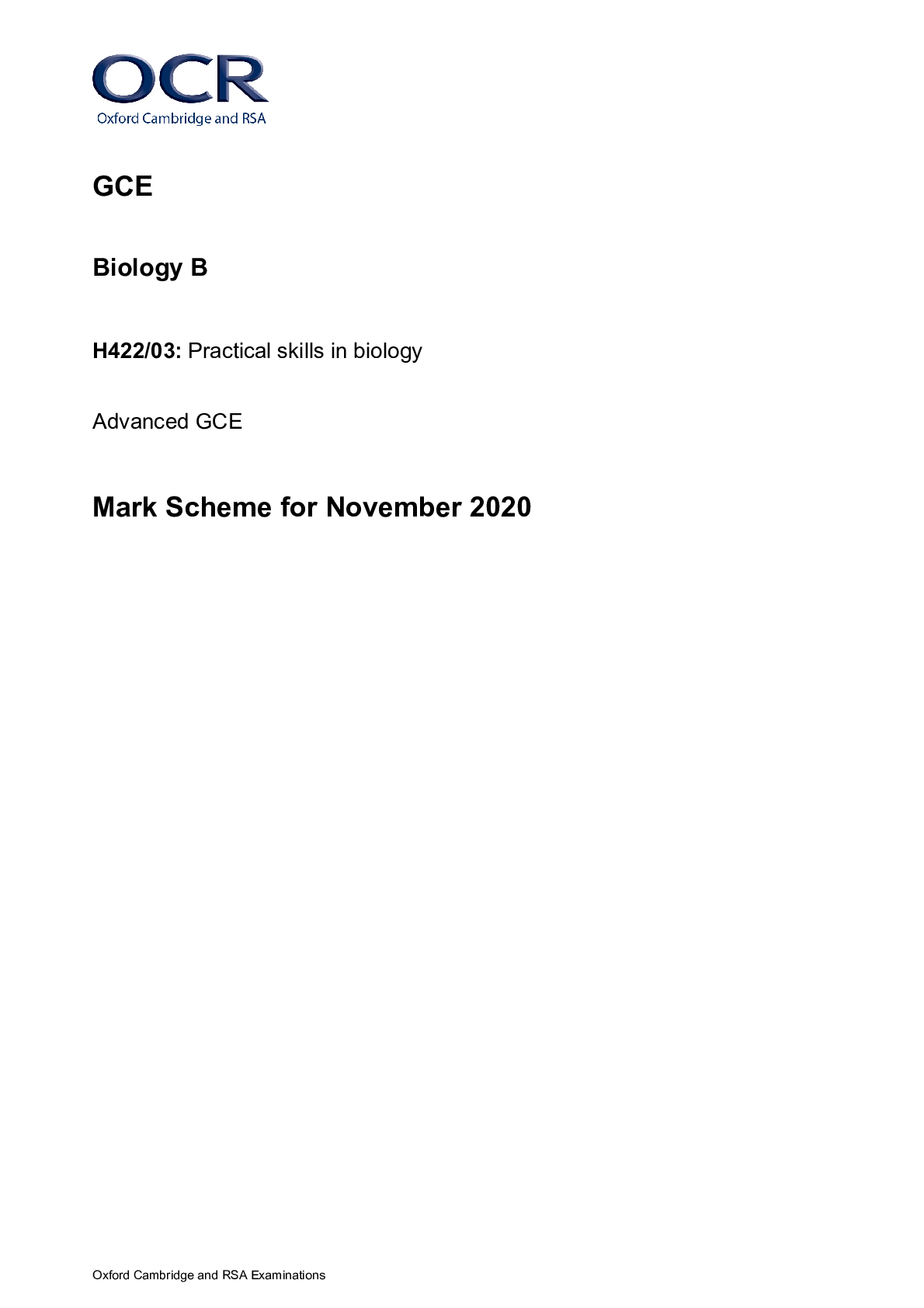
Buy this document to get the full access instantly
Instant Download Access after purchase
Buy NowInstant download
We Accept:

Reviews( 0 )
$6.50
Can't find what you want? Try our AI powered Search
Document information
Connected school, study & course
About the document
Uploaded On
Oct 07, 2022
Number of pages
20
Written in
Additional information
This document has been written for:
Uploaded
Oct 07, 2022
Downloads
0
Views
122

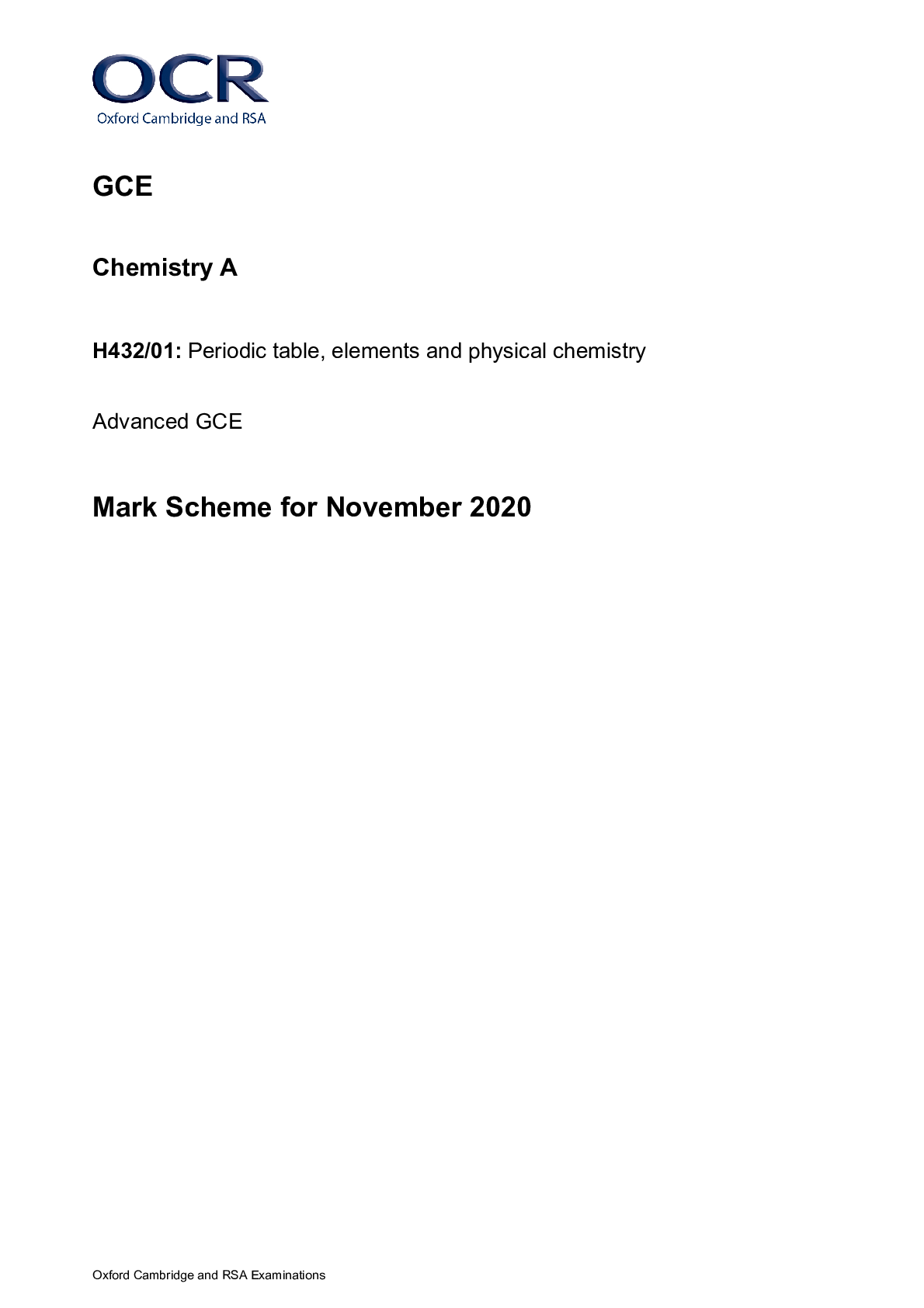


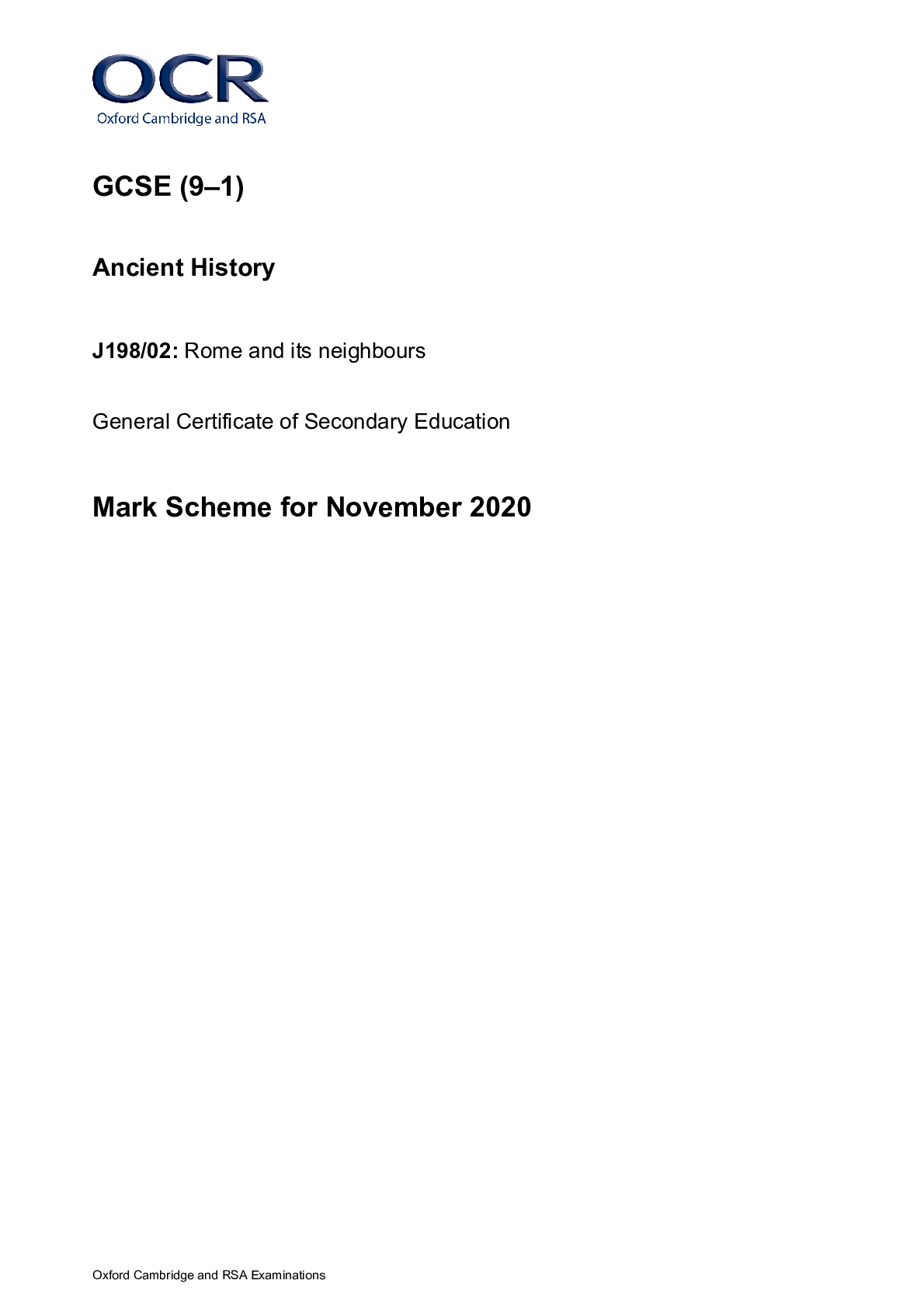




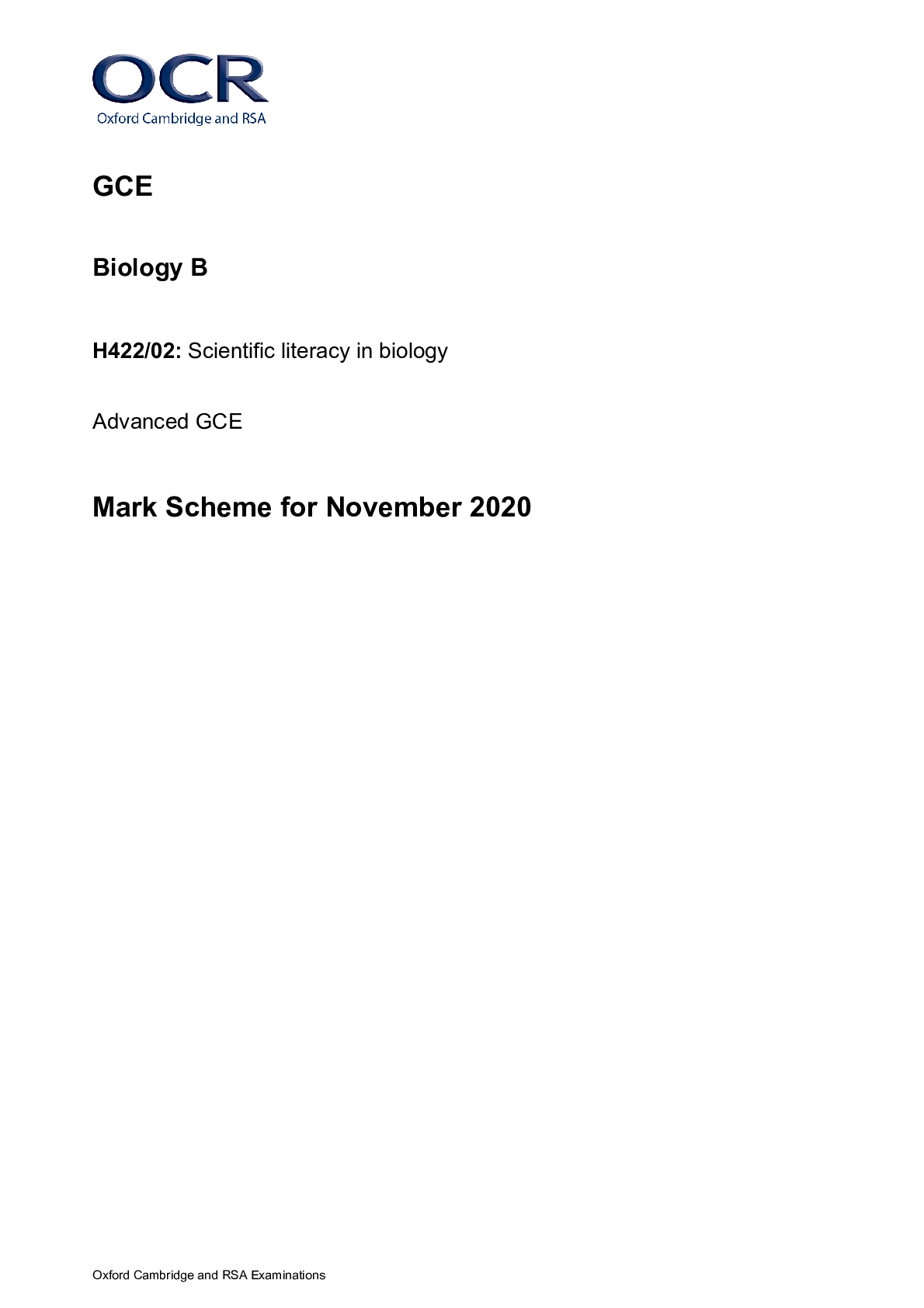
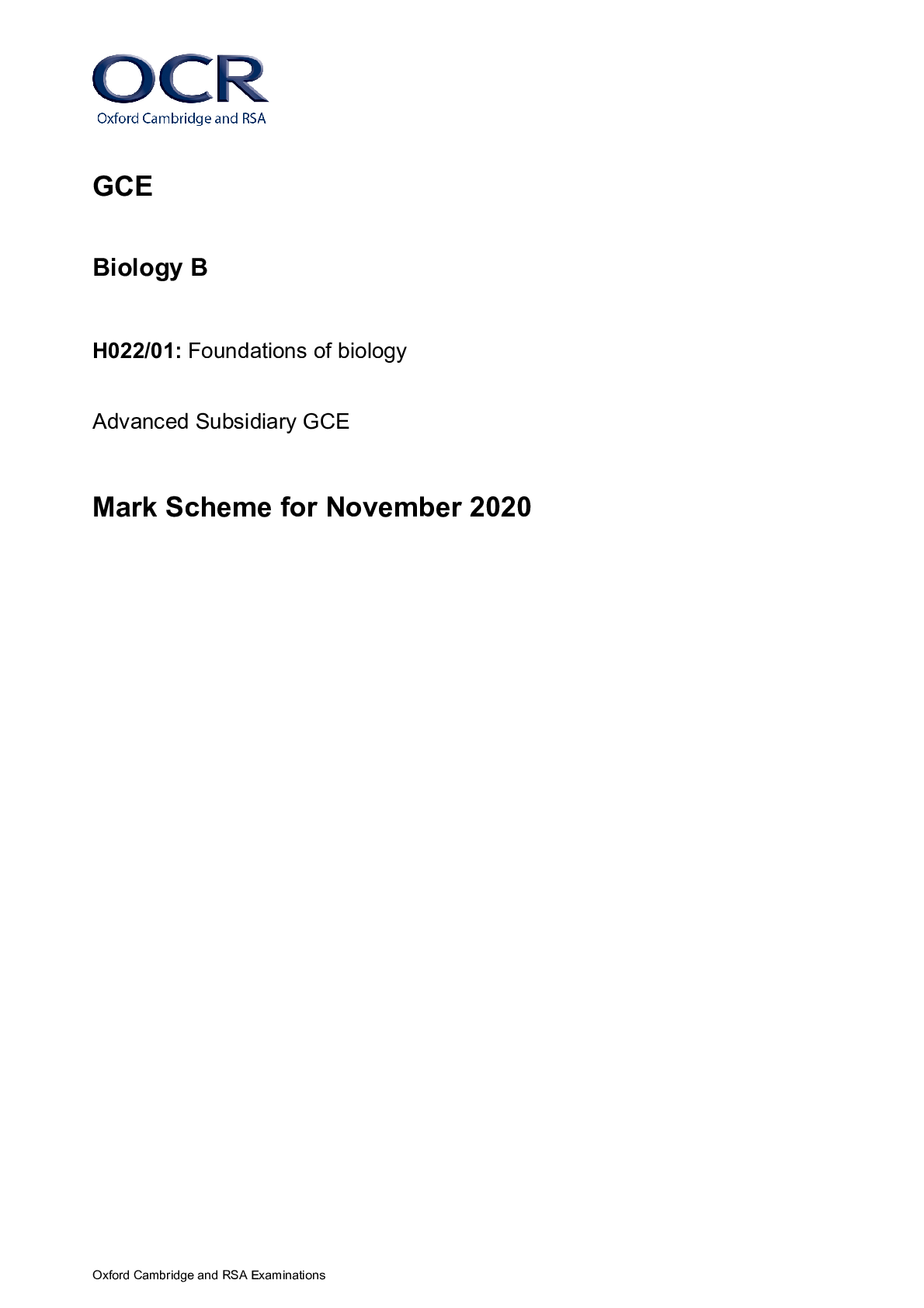



.png)




